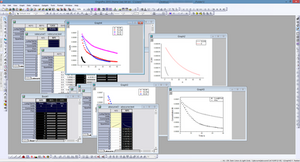Software:Origin
 | |
| Developer(s) | OriginLab Corporation |
|---|---|
| Stable release | 2018b SR1
/ April 24, 2018 |
| Operating system | Microsoft Windows |
| Available in | English, German, and Japanese. |
| Type | Data analysis |
| License | Proprietary |
| Website | originlab |
Origin is a proprietary computer program for interactive scientific graphing and data analysis. It is produced by OriginLab Corporation, and runs on Microsoft Windows. It has inspired several platform-independent open-source clones like SciDAVis.
Graphing support in Origin includes various 2D/3D plot types.
Data analyses in Origin include statistics, signal processing, curve fitting and peak analysis. Origin's curve fitting is performed by a nonlinear least squares fitter which is based on the Levenberg–Marquardt algorithm.
Origin imports data files in various formats such as ASCII text, Excel, NI TDM, DIADem, NetCDF, SPC, etc. It also exports the graph to various image file formats such as JPEG, GIF, EPS, TIFF, etc. There is also a built-in query tool for accessing database data via ADO.
Features

Origin is primarily a GUI software with a spreadsheet front end. Unlike popular spreadsheets like Excel, Origin's worksheet is column oriented. Each column has associated attributes like name, units and other user definable labels. Instead of cell formula, Origin uses column formula for calculations.
Recent versions of Origin have introduced and expanded on batch capabilities, with the goal of eliminating the need to program many routine operations. Instead the user relies on customizable graph templates, analysis dialog box Themes which save a particular suite of operations, auto recalculation on changes to data or analysis parameters, and Analysis Templates™ which save a collection of operations within the workbook.
Origin also has a scripting language (LabTalk) for controlling the software, which can be extended using a built-in C/C++-based compiled language (Origin C). Other programming options include an embedded Python environment, and an R Console plus support for Rserve.
Origin can be also used as a COM server for programs which may be written in Visual Basic .NET, C#, LabVIEW, etc.
Origin project files (.OPJ) can be read by the open-source library liborigin.
There is also a free component (Orglab) maintained by Originlab that can be used to create (or read) OPJ files. A free Viewer application is also available .
Editions and support
Origin is available in two editions, the regular version Origin and the pricier OriginPro. The latter adds additional data analysis features like surface fitting, short-time Fourier Transform, and more advanced statistics.[1]
Technical support is available to registered users via e-mail, online chat, and telephone. A user forum http://originlab.com/forum is also available, and posts are routinely answered by OriginLab staff and others in the user community.
There are a few version types that have been offered from Origin and OriginPro as personal, academic, government and student versions. However, the student version is not available for Southeast Asian countries such as Singapore, Malaysia, Thailand, Philippines and Laos.
History
Origin was first created for use solely with microcalorimeters manufactured by MicroCal Inc. (acquired by Malvern Instruments in 2014[2]) The software was used to graph the instruments data, and perform nonlinear curve fitting and parameter calculation.
The software was first published for the public in 1992 by Microcal Software, which later was renamed to OriginLab Corporation,[3] located in Northampton, Massachusetts .
Release history
- 2018/4/24 Origin 2018b. Matrices embedded in workbook, Worksheet/matrix data preview, Dynamic graph preview in analysis, Distributed batch processing on multi-core CPU (app).
- 2017/11/9 Origin 2018. Cell formula, Unicode, Bridge chart.
- 2016/11/10 Origin 2017. Trellis Plot, Geology fill patterns, JavaScript support from Origin C.
- 2015/10/23 Origin 2016. First version to support Apps in Origin, also added R support.
- 2014/10 Origin 2015[4] added graph thumbnail previews, project search, heat map, 2D kernel density plot and Python support.
- 2013/10 Origin 9.1[5] SR0 added support for Piper diagram, Ternary surface plot etc.
- 2012/10 Origin 9 with high performance OpenGL 3D Graphing, orthogonal regression for implicit/explicit functions
- 2011/11 Origin 8.6, first version in 64bit
- 2011/04 Origin 8.5.1
- 2010/09 Origin 8.5.0
- 2009/10 Origin 8.1
- 2009/08 Origin 8 SR6
- 2007/12 Origin 8 SR1[6]
- 2007/10 Origin 8[7]
- 2006/01 Origin 7.5 SR6
- 2003/10 Origin 7.5
- 2002/02 Origin 7.0
- 2000/09 Origin 6.1
- 1999/06 Origin 6.0
- 1997/08 Origin 5.0
- 1995/02 Origin 4.1
- 1994/07 Origin 3.5
- 1993/08 Origin 2.9
- 1993/?? Origin 2[8]
Alternatives and clones
Similar proprietary software includes:
- SigmaPlot
- GraphPad Prism
- IGOR Pro
- MagicPlot
- Plotly – Plotting library and styling interface for R, Python, MATLAB, Julia, and Perl.
- JMP (statistical software)
- QtiPlot
- STATISTICA
Open-source projects inspired by Origin:
- SciDAVis, a fork of QtiPlot
- LabPlot, project merged with SciDAVis
- Veusz, Qt based, similar to SciDAVis, well maintained
- SciGraphica, dormant since 2005
Other open-source graphing and data analysis software:
- gnuplot, script-driven plotting
- R, statistics
- Fityk, data vizualisation and fitting
- Matplotlib, a plotting library for the Python (programming language)
- QSoas, a command-driven data analysis and fitting program
- SageMath, an interface for Matplotlib and other plotting software
References
- ↑ Review article in Scientific Computing (OriginPro 8)
- ↑ Malvern Instruments Completes Acquisition of MicroCal and Announces Purchase of Archimedes Product From Affinity Biosensors , Malvern Instruments press release, July 25, 2014.
- ↑ EVISA Company Database
- ↑ Desktop Engineering, Oct 2014
- ↑ Business Wire Oct 23, 2013
- ↑ Drug Discovery & Development magazine: Vol. 11, No. 2, February, 2008, pp. 30-32
- ↑ NASA Tech Briefs Product of the Month
- ↑ J. Am. Chem. Soc., Vol. 115. No. 8, 1993, p. 3396
External links
- OriginLab Documentation
- Origin C Documentation
- Origin Blog
- HTML Dialog from Origin C with JavaScript support

